| (Clicking
on the thumbnail images will launch a new window and a larger version
of the thumbnail.) |
| Last updated: September 16, 2004. |
Cephalophus sylvicultor (silvicultor)
Order: Artiodactyla
Family: Bovidae
1) General Zoological Data
“Duiker antelope (Cephalophini;Simpson, 1945) constitute a distinct monophyletic group of African ungulates in the family Bovidae whose evolutionary relationships within and across tribal divisions are largely unclear. Two genera are currently recognized, the monotypic Sylvicapra (a grassland specialist) and the highly diversified Cephalophus which includes 18 species of forest duiker (Grubb, 1993; Nowak, 1999). Apart from these obvious differences in habitat preference, Sylvicapra is further distinguished from Cephalophus in that horns are usually present only in the males, are sharply pointed, and rise above the plane of the face (Ansell, 1971)” (from, v. Vuuren & Robinson, 2001). Duikers (Africaans for “diver” – because of their “diving” into the bushes – Gotch, 1979) are widespread in Africa . The yellow-backed duiker is a West African species, extending from Sierra Leone to Gabon and east into the Congo . They are not uncommon in zoological gardens and reproduce there readily. The mostly nocturnal animals weigh between 45 and 80 kg and have short, straight horns that are slanted backwards. The orange-white portion of the back is made of erectile hair. Their maximum life span in zoos is 17 years 4 months (Jones, 1993). “Cephalophus” refers to the crest of hair on the head; sylvicultor derives from the Latin for woods (Gotch, 1979).
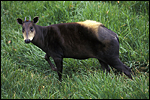 |
Yellow-backed duiker at San Diego Zoo. |
2) General Gestational Data
The length of gestation is 7 months with the production of singletons, rarely twins. Mentis (1972), however, suggested that the length of gestation is only 4 months. The neonatal weight is 6 kg (Lumpkin & Kranz, 1984).
3) Implantation
No data on early implantation are available.
4) General Characterization of the Placenta
Duikers have an epitheliochorial, cotyledonary placenta. The placenta here studied weighed 390 g, had 17 cotyledons that measured 5x0.5 cm, and had a short, torn umbilical cord. The neonate did well. Mossman (1987) described the placenta of Sylvicapra as being polycotyledonary with 22-56 flat cotyledons. He referred to a study of their uteri and identified specific implantation sites, caruncles (Lee et al., 1977).
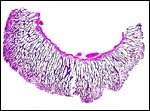 |
One of the duiker's cotyledons with somewhat edematous villi due to autolysis. |
5) Details of fetal/maternal barrier
This is a simple cuboidal trophoblastic cover of villi with a moderate number of binucleate cells. No pigmented subchorial trophoblast was present in this placenta. The villi are apparently edematous, however, this is a frequent feature of these placentas that have been on the ground for some hours before being collected by the keepers.
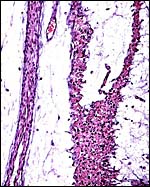 |
Low power view of artifactually edematous adjacent villi with autolyzed trophoblast. |
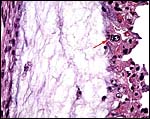 |
Trophoblast with binucleate cell at arrow. |
6) Umbilical cord
The umbilical cord had been torn and was incompletely present. Nevertheless, the gross appearance gave the impression of there having been four vessels. Doubtless there is an allantoic duct, but it was not sectioned. Starck (1957) does not provide data on this species, but lists Sylvicapra grimmia abyssinica as having a 5 cm long umbilical cord.
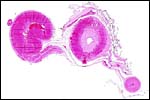 |
Portions of remaining umbilical cord with small vessels, beyond the separation of the allantoic duct into the allantoic cavity. |
7) Uteroplacental circulation
This has not been described.
8) Extraplacental membranes
Amnion has flat epithelium; the allantoic epithelium of this specimen was autolyzed.
9) Trophoblast external to barrier
Presumably there is no trophoblastic invasion of the uterus.
10) Endometrium
Not available.
11) Various features
No significant ones known to me.
12) Endocrinology
I know of no studies on duikers.
13) Genetics
This species has 60 chromosomes, all acrocetrics except for the submetacentric X-chromosome (Hard, 1969; Hsu & Benirschke, 1971). A typical karyotype is shown below. The zebra duiker (Cephalophus zebra) has 58 chromosomes, with a pair of submetacentric autosomes, while the Maxwell duiker (Cephalophus maxwelli) has 2n=60 with all being acrocentrics (Hsu & Benirschke, 1977). Considerably more investigations on duiker karyotypes and including FISH studies were undertaken by Robinson et al. (1996). Numerous hybrids have been described, even occurring between the two major genera (Gray, 1972), but the yellow-backed duiker is not mentioned by her.
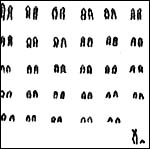 |
Karyotype of male yellow-backed duiker from the San Diego Zoo. |
14) Immunology
I am not aware of any data.
15) Pathological features
Griner (1983) did not study this species, and he found only intestinal problems in two other duikers. Macivor & Horak (2003) collected ixodid ticks from common duikers, and Ogunsanmi et al. (2001) reported salmonellosis in grey duikers and the development of antibodies in bushmeat handlers. They drew attention to this potential threat to consumers of bushmeat.
16) Physiologic data
I am not aware of any studies.
17) Other resources
Numerous cell strains from different animals are available from CRES by contacting Dr. Oliver Ryder at oryder@ucsd.edu .
18) Other remarks – What additional Information is needed?
Implanted placentas, cord length, early stages and endocrinological studies are needed.
Acknowledgement
The animal photograph in this chapter comes from the Zoological Society of San Diego.
References
Ansell, W.F.H.: Family Artiodactyla. In, The Mammals of Africa : An Identification Manual. J. Meester and H.W. Setzer, eds. Pp. 15-83. Smithsonian Institution Press, Washington , D.C. , 1971.
Gotch, A.F.: Mammals – Their Latin Names Explained. Blandford Press, Poole , Dorset , 1979.
Gray, A.P.: Mammalian Hybrids. A Check-list with Bibliography. 2 nd edition.
Commonwealth Agricultural Bureaux Farnham Royal, Slough , England , 1972.
Griner, L.A. : Pathology of Zoo Animals. Zoological Society of San Diego , San Diego , California , 1983.
Grubb, P.: In, Mammal Species of the World: A Taxonomic and Geographic Reference. D.E. Wilson and D.M. Reeder, eds. Pp. 410-412. Smithsonian Institution Press, Washington , D.C. , 1993.
Hard, W.L.: The chromosomes of duikers. Mammal. Chromosomes Newsl. 10:216, 1969.
Hsu, T.C. and Benirschke, K.: An Atlas of Mammalian Chromosomes. Vol. 5: Folio 242, 1971. Springer-Verlag , N.Y.
Hsu, T.C. and Benirschke, K.: An Atlas of Mammalian Chromosomes. Vol. 10: Folio 502, 1977. Springer-Verlag , N.Y.
Jones, M.L.: Longevity of ungulates in captivity. Intern. Zoo Yearbk. 32:159-169, 1993.
Lee, S.Y., Mossman, H.W., Mossman, A.S. and del Pino, G.: Evidence of a specific nidation site in ruminants. Amer. J. Anat. 150:631-640, 1977.
Lumpkin, S. and Kranz, K.R.: Cephalophus sylvicultor. Mammalian Species. 225:1-7, 1984.
Macivor, K.M. and Horak, I.G.: Ixodid ticks of angora and boar goats, grysbok, common duikers, kudus and scrub hares in Valley Bushveld in the Eastern Cape Province , South Africa . Onderstepoort J. Vet. Res. 70:113-120, 2003.
Mentis, M.T.: A review of some life history features of the large herbivores of Africa . The Lammergeyer16:1-89, 1972.
Mossman, H.W.: Vertebrate Fetal Membranes. MacMillan, Houndmills, 1987.
Nowak, R.M.: Walker 's Mammals of the World. 6 th ed. The Johns Hopkins Press, Baltimore, 1999.
Ogunsanmi, A.O., Taiwo, V.O., Iroeche, P.C. and Sobaloju, S.O.: Serological survey of salmonellosis in grey duiker (Sylvicapra grimmia) in Asejire, Irewole Local Government Area, Osun State , Nigeria . Afr. J. Med. Sci. 30:115-118, 2001.
Robinson, T.J., Wilson , V., Gallagher, D.S. Jr., Taylor , J.F., Davis , S.K., Harrison , W.R. and Elder, F.F.: Chromosomal evolution in duiker antelope (Cephalophinae: Bovidae): karyotype comparisons, fluorescence in situ hybridization, and rampant X chromosome variation. Cytogenet. Cell Genet. 73:116-122, 1996.
Starck, D.: Ueber die Länge der Nabelschnur bei Säugetieren. Z. Säugetierk. 22:77-86, 1957.
Vuuren, B. Jansen v. and Robinson, T.J.: Retrieval of four adaptive lineages in duiker antelope: Evidence from mitochondrial DNA sequences and fluorescence in situ hybridization. Mol. Phylogen. Evol. 20:409-425, 2001.
